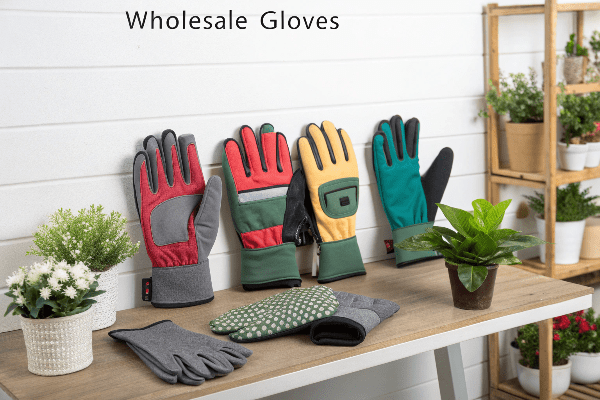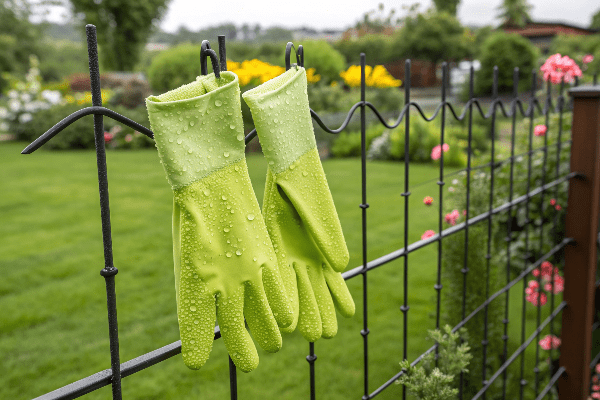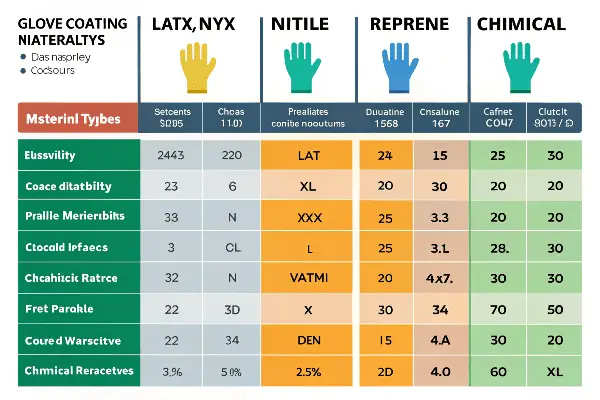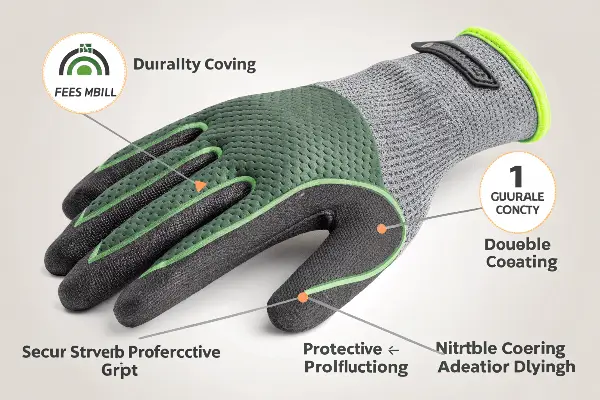Your customers demand gardening gloves that protect their hands while staying comfortable all day. Poor quality gloves lead to complaints and returns.
The best gardening gloves combine proper grip, durability, and breathability. Top sellers include nitrile-coated all-purpose gloves, thorn-proof rose gloves, and cut-resistant safety models.

Top 10 Gardening Gloves for PPE Wholesalers.
After 15 years of manufacturing work gloves1 in China, I have learned something important. When gardeners buy gloves from your store, they want one thing above all else – gloves that work. Let me share which 10 types consistently deliver happy customers and repeat sales.
What Makes a Gardening Glove Worth Stocking?
Gardeners hate when their gloves fail them. They want protection without losing their ability to feel what they are doing.
Successful gardening gloves balance protection, dexterity, and comfort. They must resist punctures, provide good grip, and allow precise finger movement for planting and weeding tasks.

Essential Features of Quality Gardening Gloves.
Last month, one of my wholesaler partners in Germany shared a story that opened my eyes. A customer returned three different pairs of gardening gloves2 in one week. The first pair was too thick for seed planting. The second pair tore on rose thorns. The third pair made her hands sweat too much. This taught me why we need to think about different gardening tasks when we design gloves. At BullSafety, we work with our partners to understand their local markets. Some regions focus on vegetable gardening and need lightweight, breathable gloves3. Others have many rose gardens and need thorn-proof options4. We help you choose the right mix based on your customer feedback. Our ISO9001 and CE certifications ensure quality, but real success comes from matching glove features to actual gardening needs.
How Do Material Choices Impact Customer Satisfaction?
The coating on gardening gloves makes or breaks the user experience. Wrong materials lead to slipped tools and frustrated gardeners.
Nitrile coatings provide the best grip and durability for most garden tasks. Microfoam offers precision for delicate work, while sandy nitrile excels in wet conditions.

Gardening Glove Coating Materials Guide.
I remember visiting a garden center in California three years ago. The owner showed me a shelf full of returned gloves – all because customers could not grip their tools properly. The gloves looked good but used cheap PVC coating that became slippery when wet. This experience shaped how we approach material selection at BullSafety. We offer five main coating types, each for specific gardening conditions. Our microfoam coating5 works best for transplanting seedlings because it provides excellent tactile feel. Sandy nitrile gives superior grip on wet tools and in dewy morning conditions. Foam nitrile6 balances comfort and durability for all-day wear. Standard latex7 remains popular for dry conditions and budget-conscious customers. PU coatings8 offer the lightest feel for precision tasks like pruning. When we co-design gloves with partners, we analyze their climate and customer preferences. Desert regions need UV-resistant materials. Coastal areas require salt-water resistant coatings. This customization approach reduces returns and builds customer loyalty.
Which Features Drive Repeat Purchases?
Gardeners replace gloves that wear out quickly or feel uncomfortable. Smart features keep them coming back to your store.
Extended cuffs prevent dirt entry, reinforced fingertips extend lifespan, and washable materials maintain hygiene. These features turn one-time buyers into loyal customers.

Durability Features That Matter to Gardeners.
Two years ago, a landscaping company owner from Texas contacted me about employee complaints. Workers were going through three pairs of gloves per month because fingertips kept wearing through. We redesigned their gloves with double-thickness fingertip reinforcement9 using our advanced manufacturing techniques. Now their gloves last six months or more. This experience taught me that different features matter to different users. Home gardeners prioritize comfort and washability. Professional landscapers need maximum durability and cut resistance. Greenhouse workers require chemical resistance for fertilizer handling. At BullSafety, we manufacture gloves with ANSI cut resistance ratings10 from A1 to A5, depending on your market needs. Our extended cuff designs protect wrists and forearms during heavy brush clearing. Seamless knit construction11 eliminates pressure points for all-day comfort. We also offer antimicrobial treatments12 to prevent odor buildup in hot climates. The key insight for wholesalers is this – customers pay more for gloves that last longer and feel better. Higher quality gloves generate better margins and fewer complaints.
The Top 10 Gardening Gloves for Your Inventory
1. All-Purpose Nitrile Palm Gloves
Best seller for 80% of garden tasks. Nitrile coating provides excellent grip and water resistance.
2. Heavy-Duty Leather Work Gloves
Premium option for landscapers and serious gardeners who need maximum durability.
3. Thorn-Proof Rose Garden Gloves
Specialty item with reinforced palms and extended cuffs for handling thorny plants safely.
4. Lightweight Microfoam Precision Gloves
Perfect for seed planting, transplanting, and delicate garden work requiring finger sensitivity.
5. Chemical-Resistant Nitrile Gloves
Essential for customers who apply fertilizers, pesticides, or work with garden chemicals.
6. Waterproof Sandy Nitrile Gloves
Superior grip in wet conditions, popular in regions with frequent rain or irrigation.
7. Cut-Resistant Garden Safety Gloves
ANSI-rated protection for pruning, trimming, and handling sharp garden tools.
8. Breathable PU Palm Gloves
Ultra-lightweight option for hot climates and customers with sensitive skin.
9. Extended Cuff Garden Gloves
Protection against scratches, dirt, and insects during heavy brush clearing work.
10. Budget-Friendly Latex Gloves
Entry-level option for casual gardeners and seasonal workers seeking basic protection.
Conclusion
These 10 gardening glove types cover every customer need while ensuring profitability and satisfaction for wholesalers.
-
Discover the top-rated work gloves that ensure comfort and durability for gardeners, enhancing their gardening experience. ↩
-
Explore this link to discover the best gardening gloves tailored for various tasks, ensuring comfort and efficiency in your gardening activities. ↩
-
Discover top-rated lightweight, breathable gloves to keep your hands cool and comfortable during gardening, ensuring you choose the best option for your needs. ↩
-
Learn about thorn-proof gardening gloves and their significance in protecting your hands while gardening, especially in rose gardens. ↩
-
Explore this link to understand how microfoam coating enhances grip and tactile feel, perfect for gardening tasks. ↩
-
Discover why foam nitrile gloves are ideal for gardeners seeking comfort and durability during long hours of work. ↩
-
Learn why latex-coated gloves are a popular choice for dry gardening conditions and how they balance cost and performance for gardeners. ↩
-
Learn how PU coatings enhance precision and comfort in gardening gloves, helping you choose the best option for detailed tasks like pruning. ↩
-
Exploring the benefits of double-thickness fingertip reinforcement can help you choose gloves that last longer and perform better in demanding tasks. ↩
-
Understanding ANSI cut resistance ratings is crucial for selecting the right gloves for safety and durability in various work environments. ↩
-
Discover how seamless knit construction enhances glove comfort and durability, helping you choose the best gloves for long-lasting, all-day wear. ↩
-
Learn how antimicrobial treatments in gloves help prevent odor and bacteria, ensuring comfort and hygiene for workers in hot or demanding environments. ↩



